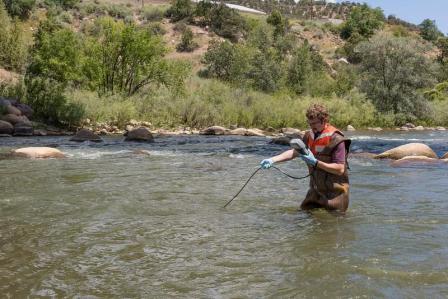EPA Highlights for the Week of August 17, 2015

- Update on Gold King Mine Spill Response Efforts
- Proposal to Reduce Methane Emissions from Oil & Gas Sector
- School Indoor Air Quality App Helps Protect Children
- Improving Environmental Justice for Tribes and Indigenous Peoples
Update on Gold King Mine Spill Response Efforts
 EPA is working around the clock to collect and analyze water quality information.EPA is committed to working closely with response agencies and state and local officials during the response and investigation to the Gold King Mine spill. Our primary mission is to ensure the safety of citizens, respond to concerns, and evaluate the water impacted by the spill.
EPA is working around the clock to collect and analyze water quality information.EPA is committed to working closely with response agencies and state and local officials during the response and investigation to the Gold King Mine spill. Our primary mission is to ensure the safety of citizens, respond to concerns, and evaluate the water impacted by the spill.
Read a fact sheet on the history of Gold King Mine.
View photos related to the response efforts.
Proposal to Reduce Methane Emissions from Oil & Gas Sector
 Nearly 30 percent of US methane emissions come from oil and natural gas systems.This week, EPA announced proposed commonsense measures to cut methane emissions from the oil and gas sector. This proposal continues the Obama Administration’s commitment to take action on climate change and protect public health. The new standards are designed to reduce greenhouse gas (GHG) and volatile organic compounds (VOC) emissions.
Nearly 30 percent of US methane emissions come from oil and natural gas systems.This week, EPA announced proposed commonsense measures to cut methane emissions from the oil and gas sector. This proposal continues the Obama Administration’s commitment to take action on climate change and protect public health. The new standards are designed to reduce greenhouse gas (GHG) and volatile organic compounds (VOC) emissions.
Methane, the key constituent of natural gas, is a potent GHG with a global warming potential more than 25 times greater than that of carbon dioxide. Additionally, methane is the second most prevalent greenhouse gas emitted in the United States from human activities.
School Indoor Air Quality App Helps Protect Children
 Promote a healthy learning environment at your school to reduce absenteeism, improve test scores, and enhance productivity.EPA recently launched the School Indoor Air Quality (IAQ) Assessment mobile app to provide “one-stop shop” for accessing guidance from the IAQ Tools for Schools Action Kit. The app helps address important issues such as ventilation, cleaning and maintenance, environmental asthma triggers, radon, and integrated pest management.
Promote a healthy learning environment at your school to reduce absenteeism, improve test scores, and enhance productivity.EPA recently launched the School Indoor Air Quality (IAQ) Assessment mobile app to provide “one-stop shop” for accessing guidance from the IAQ Tools for Schools Action Kit. The app helps address important issues such as ventilation, cleaning and maintenance, environmental asthma triggers, radon, and integrated pest management.
Download the app to help develop or enhance an IAQ management program with easy steps to help you identify and prioritize IAQ improvements in schools.
Improving Environmental Justice for Tribes and Indigenous Peoples
 EPA is reinforcing its commitment to tribal communities, especially in addressing issues of environmental justice.One year ago, EPA released its Policy on Environmental Justice for Working with Federally Recognized Tribes and Indigenous Peoples. EPA’s technical assistance and guidance has helped tribal communities become more engaged in public participation processes, and effect positive environmental justice outcomes. The policy outlines how EPA will engage and make decisions based on input from tribal governments, Indigenous peoples, and others living in Indian country. As more tribal communities participate, the more likely indigenous social, economic, cultural, and spiritual interests will be preserved and enhanced for future generations.
EPA is reinforcing its commitment to tribal communities, especially in addressing issues of environmental justice.One year ago, EPA released its Policy on Environmental Justice for Working with Federally Recognized Tribes and Indigenous Peoples. EPA’s technical assistance and guidance has helped tribal communities become more engaged in public participation processes, and effect positive environmental justice outcomes. The policy outlines how EPA will engage and make decisions based on input from tribal governments, Indigenous peoples, and others living in Indian country. As more tribal communities participate, the more likely indigenous social, economic, cultural, and spiritual interests will be preserved and enhanced for future generations.
Read a blog post by Tom B.K. Goldtooth of the Indigenous Environmental Network, providing insight on the importance of meaningful collaboration with tribes and indigenous peoples.
